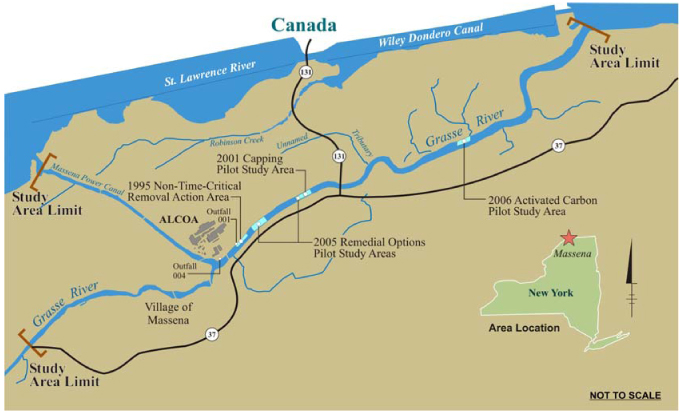Overview | Ice Jam Event Details | Ice Breaking Demonstration Details | Ice Control Structure
Overview
In 2003, a severe ice-jam event occurred in the lower Grasse River. The ice jam formed directly over the 2001 Capping Pilot Study area, and was severe enough to scour the cap and some of river bottom material.
In response to this event, Arconic (formerly Alcoa) assembled an ice expert team and conducted a series of intensive investigations in 2003 and 2004 to understand what happened, why, and how often these events occur. Results of the ice investigations indicated that ice jams capable of scouring and redistributing PCBs buried in the river sediments can occur once every 7 to 10 years in the upper approximately 1.8 miles of lower Grasse River (between the Power Canal and approximately one-third of a mile upstream of the Route 131 Bridge).
This ice jam scour was not previously known to occur in the Grasse River and the cap installed as part of the 2001 Capping Pilot Study was not designed to withstand the forces from these events. As a result, the company began to evaluate possible long- and short-term options for controlling ice jam related sediment scour for incorporation into a potential remedial solution for the river.
A number of different ice control options have been studied, including the long-term option of ice control structures such as stand-alone piers and/or construction of a dam, and the short term option of mechanical break-up of river ice. The Ice Breaking Demonstration Project was carried out in March 2007 and involved breaking the intact ice cover throughout a seven-mile stretch of the Grasse River. Based on implementation and public safety related concerns none of these options were retained for further evaluation. Instead, to address potential impacts from ice jams, armored capping was evaluated and selected by EPA in the Record of Decision to protect the river bottom in the section of river known to be vulnerable to ice jam related scour. The armored cap included placement of three layers of material, starting with sand with granulated activated carbon as chemical isolation layer (1), then gravel as filtering layer (2), and finally, a layer of armor stone (3).
An ice jam event occurred in March 2022 which resulted in limited scouring of the cap and sediment immediately upstream of the Route 131 Bridge. Historically, ice jams capable of scouring the river bottom were known to occur down to approximately one-third of a mile upstream of the Route 131 Bridge and have not occurred this far down river. As a result, the construction of the cap in the damaged area was not designed for the forces resulting from the jam. The armored cap constructed in the river upstream of the area, which was designed to withstand ice jam forces, was not damaged. Additional work in the river was determined to be necessary to repair the damaged cap in this section of the river.

Back to top
